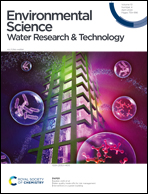Environmentally friendly TDS removal from waste water by electrochemical ion exchange batch-type recirculation (EIR) technique†
Abstract
The increasing prevalence of total dissolved solids (TDS), Cl−, SO42−, total suspended solids (TSS), BOD and COD in industrial effluent necessitates pioneering electrochemical approaches for their efficient removal. Synthetic industrial wastewater (SWW) and tannery industrial processing wastewater (TWW) were collected, and studies were performed to explore the synergistic optimization of the current density (CD), anolyte, and cathode compartment effluent volume ratio selection to enhance TDS and other toxic effluent removal efficiencies, where the time did not exceed 8 h. The electrochemical ion exchange batch-type recirculation reactor (EIR) approach was examined with the help of ruthenium oxide-coated titanium (Ru2O/Ti) as the anode and stainless steel (SS) as the cathode, which were separated by a middle compartment. Utilizing a three compartment setup as an electrochemical cell batch-type recirculation design, we investigated the impact of varying the current density on the TDS removal rate and power consumption. In these compartments, we have fixed an anion exchange membrane (AEM-NEOSEPTA) and a cationic exchange resin (CER-AMBERLITE IR 120), where SWW/TWW were allowed to recirculate during the operating time of the reactor. The SWW was treated at various current densities, including 20, 40, 60, 80 and 90 mA cm−2. The maximum removal of Cl− (93%), SO42− (93%), TSS (93%), TDS (93%), BOD5 (93%), and COD (93%) was achieved at a 1 : 2 volume ratio and an optimum low current density of 40 mA cm−2. Our findings reveal an optimal current density range, balancing the removal efficiency and energy consumption of 0.9682 kW h kg−1. These findings indicated that under optimized conditions, the maximum removal efficiencies of Cl−, SO42−, TSS, TDS, BOD5 and COD were 95%, 89%, 89%, 83%, 92% and 89%, respectively from TWW. The optimized system demonstrates superior efficiency in reducing TDS levels, highlighting the significance of parameter tuning in the electrochemical TDS removal process in tannery high saline effluent. This research contributes to the development of sustainable water treatment strategies by presenting a comprehensive approach for enhancing TDS removal through the systematic optimization of key operational parameters. The insights gained from this study will inform the design and implementation of electrochemical systems for TDS-laden effluent treatment, offering a practical pathway toward more efficient and environmentally conscious water remediation practices.



 Please wait while we load your content...
Please wait while we load your content...